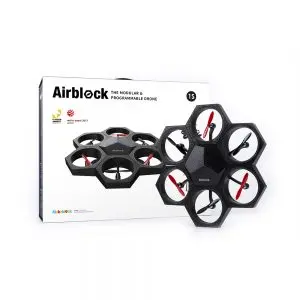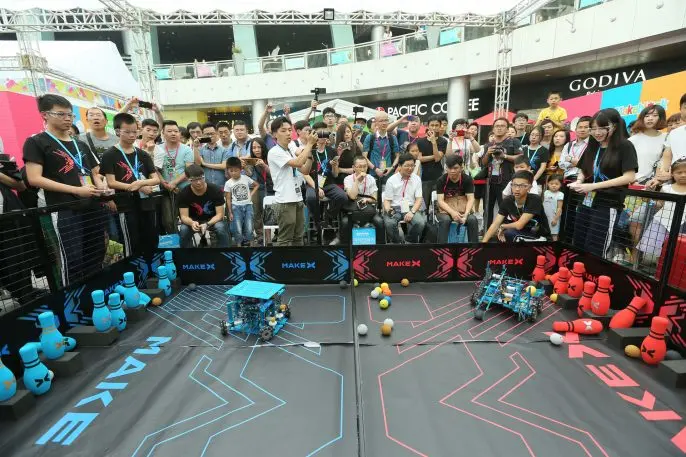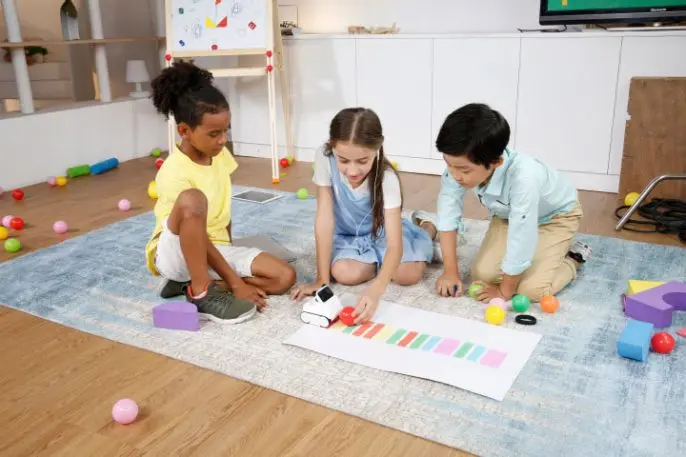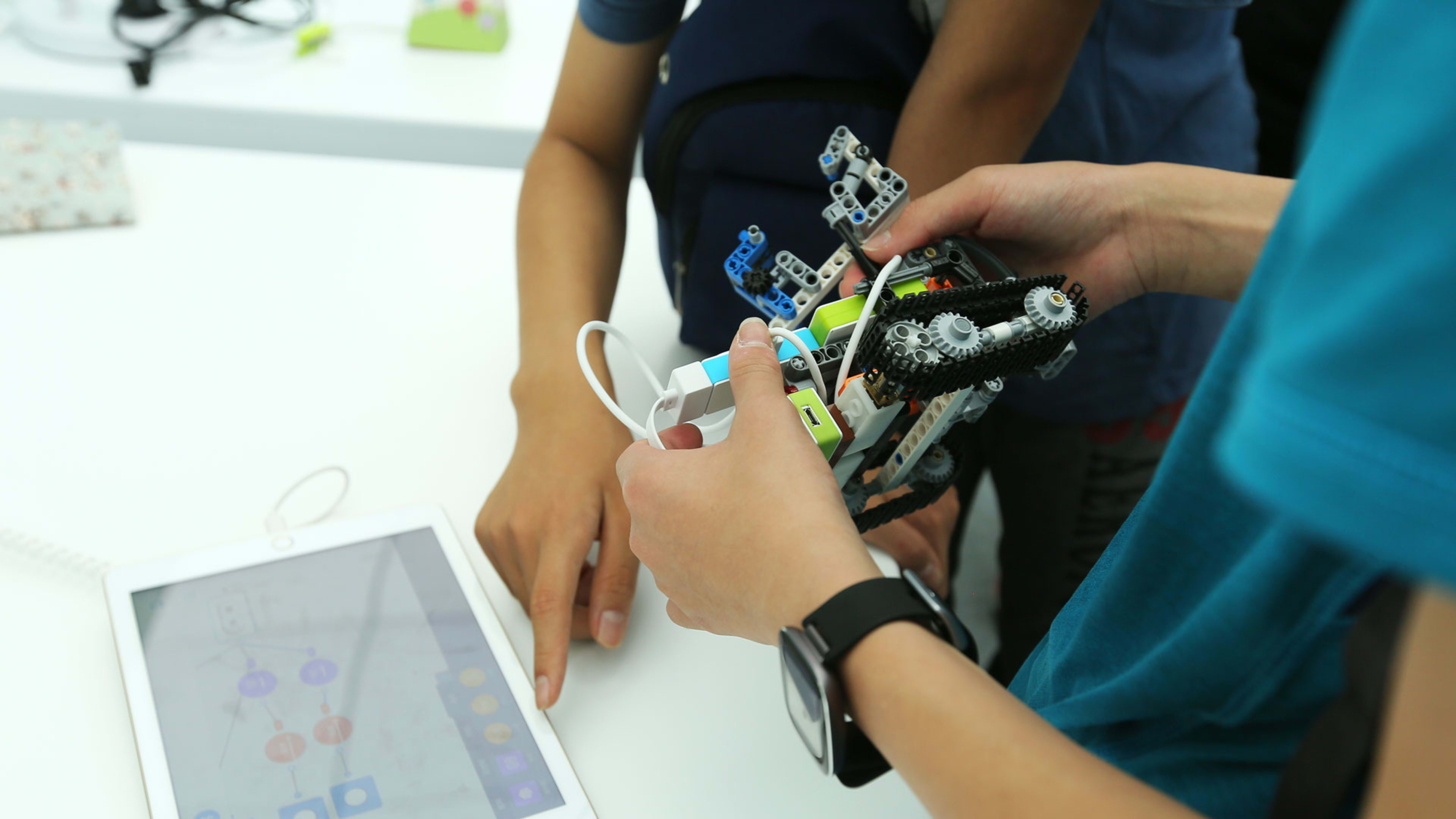Jianjun “Jasen” Wang wasn’t exposed to technology as a kid. He was an “ordinary, poor child,” the 33-year-old founder and CEO of Makeblock, says at his company’s Shenzhen office. He’s wearing jeans, glasses, and a company T-shirt that reads, “Instruct your Dreams.” “My parents didn’t have the spare money for me to learn something like [robotics].”
Two decades later, Wang’s robots are making their way into kids’ hands across the world, and have made his startup one of the pioneers in a new trend in educational tech. Launched in 2012, Makeblock produces do-it-yourself robotics kits for kids that combine mechanical, electronic, and software components—think LEGO-like pieces that can be assembled into bots and controlled with a few lines of code. The idea began when Wang was in college, studying aerodynamics and tinkering with robotics on the side. He noticed a largely unaddressed market: those interested in robots but with a limited understanding of the technology. “All the products we developed are to help people create in the physical world,” he says.
Wang initially founded Makeblock at Shenzhen-based HAX, a venture capital firm and hardware accelerator. After graduating from HAX, Wang kept the company in Shenzhen, a young city that has a strong manufacturing base and thousands of high-tech enterprises. He turned to Kickstarter to raise early funds, which also helped strengthen brand awareness and customer loyalty overseas.
The company is now a success outside of China and Asia, still a rarity among Chinese high-tech startups. Makeblock says its robots are now used by more than 6 million users across 140 countries, including in more than 25,000 schools globally. In fact, 70% of Makeblock’s revenues last year came from overseas sales, mainly through educational channels in the U.S., Europe, and Japan. At an event in Mexico in April, the company even helped set a Guinness World Record for the world’s largest robotics lesson: 971 K-12 students used Makeblock kits to learn about technology and programming.
[Animation: courtesy of Makeblock]Business is good, too. The company’s robot kits, which range in price from $79 to several hundred dollars, helped bring in $30 million in revenue last year, a 63% increase. In August, the startup closed a $44 million series C funding round, with a $367 million valuation.
Makeblock’s product platforms include drivable and flyable robotics, as well as a building block system. Targeted to 6- to 12-year-olds, these kits include motors, wires, wheels, sensors, LED lights, metal body frames, and fasteners. Components are interchangeable across platforms, enabling users to build customized robots.
Related: Shenzhen is building a mile-long superhighway for trees
To operate the robots via laptop or mobile phone, children drag and drop embedded graphics or write their own code, depending on expertise and interest levels. Makeblock’s Neuron Explorer Kit is also compatible with Apple’s Swift Playgrounds, an app to help children learn the Swift programming language.
Although Makeblock users learn basic artificial intelligence and programming skills, the process is meant to be fun. Users have designed robots that can feed pets, water plants, fetch goods, play instruments, and serve food.
“The key point is not to teach them how to code. We provide them with a tool to realize their ideas. So, programming is one way for them to tell their ideas to the machines,” Wang says.
Wang says the technological barrier to create has historically been too high for novices. “It’s very hard for them. If you provide a platform, that can make it easy,” he says.
‘There’s big money at stake’

“There’s lots of experimentation,” Levin says. “People are excited about new technologies.” For example, low-cost virtual reality is gaining traction. And at an educational conference this summer, Levin saw numerous vendors marketing robotics and electronics kits.
Makeblock operates in a cross-section of growing markets, competing against companies like Danish giant LEGO Mindstorms, New York-based littleBits, as well as startups like ArcBotics, Flybrix, Vex Robotics, and Wonder Workshop. By 2020, the global market for educational robots is expected to reach more than $6 billion, according to London-based research firm Technavio. “There’s big money at stake,” Levin says.

This contrasts with the U.S. Levin, who helped the Clinton Administration craft the first national education technology plan for K-12 public schools, said national and state governments encourage technological innovation, but that funding declined since the early 2000s. “Money is coming from repurposed dollars at the local level,” he says.
U.S. resources differ by district, and underfunded rural and urban areas are acutely impacted. “It’s absolutely uneven in that regard,” Levin says.

Beyond demographic discrepancies, Levin said there are privacy worries with educational hardware products in general, particularly as manufacturers increasingly glean consumer data. The last U.S. privacy laws governing education and data collection were passed in 1973, and Levin said schools are not equipped to manage these issues.
For Makeblock, macro trends may also be complicated, especially now that the U.S. and China are locked in a trade war. But Wang is focused on internal impediments. “I think the biggest challenge is on the people side and managing ourselves,” Wang says. “Management is challenged because the team is growing very fast.” (The company outsources the manufacturing of the hardware itself to nearby factories.)
To bolster employee engagement, the startup holds internal maker-thons. Staffers across departments join small teams that have two days to build new products using Makeblock components. With the new funding, the company intends to bolster international sales and marketing as well as research and development. Roughly half of the company’s 500 employees are already in R&D, working to refine robot kits to make them more advanced—and easier for greenhorns. “Building a robot is still hard for many normal people,” Wang says.
Joshua Bateman is based in Greater China. He can be reached @joshdbateman.
Recognize your brand’s excellence by applying to this year’s Brands That Matter Awards before the early-rate deadline, May 3.
